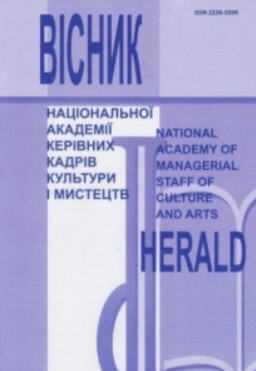ПРЕДСТАВЛЕННЯ ТРАДИЦІЙНИХ МУЗИЧНИХ ЖАНРІВ КИТАЮ У СВІТОВОМУ ПРОСТОРІ
INTRODUCING CHINA'S TRADITIONAL MUSIC GENRES TO THE WORLD
Author(s): Maryna AntoshkoSubject(s): Cultural history, Customs / Folklore, Music, History of Art
Published by: Національна академія керівних кадрів культури і мистецтв
Keywords: traditional music genres; musical art; cultural traditions; country philosophy;
Summary/Abstract: The purpose of the article is to study the presentation of traditional Chinese music genres in the world. The methodology of the study is to use historical and biographical methods in the study of this topic. The scientific novelty of the article is to explore the expediency of presenting traditional Chinese music genres in the world. After all, this question reflects both the traditions and customs of the country and raises the names of scholars of Chinese culture. The presentation of Chinese art is due to the holding of opera festivals that influence the culture of the whole country. The emergence of new theatrical acts and performances also influenced China's outlook. Conclusions. The introduction of traditional Chinese music genres in the world is due to the development of culture and education in the country. The system of thinking of Chinese culture is based on the ancient philosophy of the country. Musical art is in constant search: the nature of sound, timbre palette, forms, combining national motives. Through the combination of national traits, country philosophy, religious tendencies, elements of vocal and instrumental folklore, theater and composition, and piano culture, China's musical piano culture has become well-known in the world. It was the Suetan School and Yuege's educational system that formed the basis for the development of Chinese musical culture. Speaking about the nature of Chinese music, it should be emphasized that it has its intonation-melodic nature, which is different from European music samples. Chinese people became acquainted with the performance of European works through touring. In the early ‘70s began to reform the conservatories into musical institutes. For example, music institutions such as the conservatories in Wuhan (Hubei), Shenyang (Liaoning), Xi'an (Shaanxi), and Chengdu (Sichuan) have undergone these changes. During this period (the ‘70s), the flowering of Chinese music education began, orchestras, amateur bands appeared, research aroused curiosity, and music magazines began to be published. Teachers such as Zhou Xiaoyan, Lan Yushu, Yu Yixuan, Shen Xiang, Xi Ggui, Wen Quecheng, Li Zhishui, Wei Chixian, Man Jiangxi, Sung Xin, Hu Yan, Gao Zhilan, Do Shinji, and others start their creative activity. The revitalization of music education is in the twentieth century, which causes the development and rethinking of new turns in educational processes. The processes of formation and development of the Chinese music education system are reflected in the works of Wang Yuhe, Liu Pei, Yang Bohua, stylistic features of musical art were interested in F. Arzamanov, V. Vakulishin, Lin Hai, Liu Da-jung, Ma Gesun, Sun Tsunin, In Gen- Ira, Chang Ling, Yang Xiao Xu and more. Chinese education has interested such scholars as: Ding Yun, Yang Bohua. It should be said that much attention was paid to education, as evidenced by the work of scientists. Turning to the historical facts, it becomes known that music education began to develop during the Tang era (VII-X centuries). This led to the emergence of performing schools and the establishment of educational institutions, which allowed to expand the representation of traditional genres of the world.
Journal: Вісник Національної академії керівних кадрів культури і мистецтв
- Issue Year: 2020
- Issue No: 4
- Page Range: 104-107
- Page Count: 4
- Language: Ukrainian

